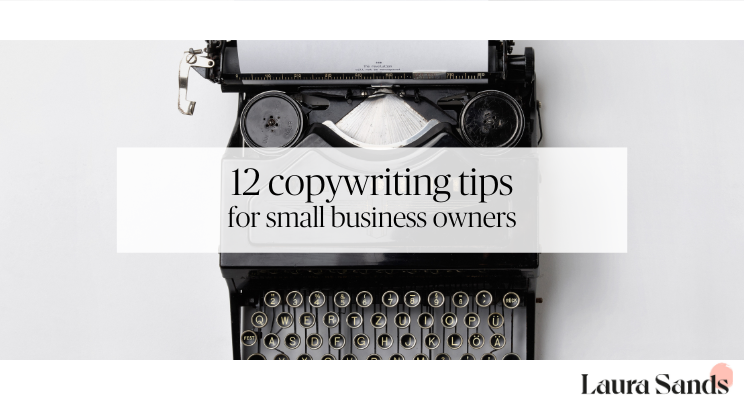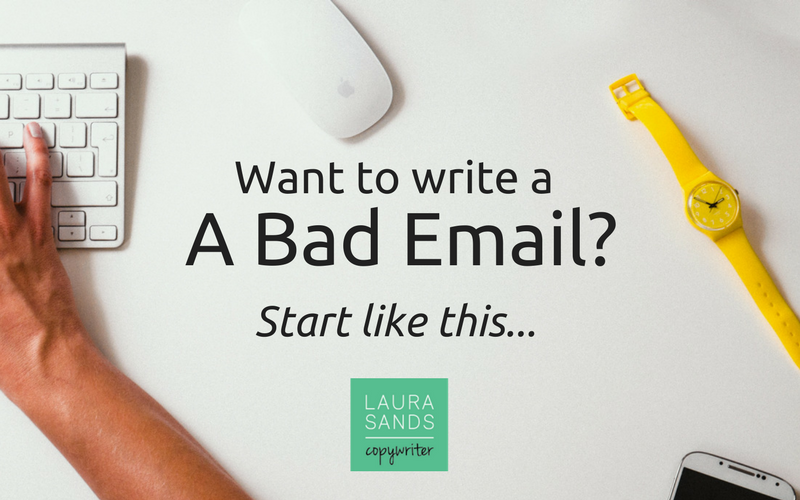
As a small business owner, you need to master a range of skills. As well as finance manager, CEO and pot washer, you need to be a copywriter. And the truth is that although copywriting seems simple at first, it can quickly become overwhelming. My copywriting tips for small business owners are just what you need!
Copywriting tips for small business owners.
Are you ready? Coffee in hand? Let’s go…
- Writing doesn’t need to be a drama. You’re just communicating with your audience. If you feel anxious as you approach your keyboard, then try some mind tricks to help you relax into it. One such trick is to pretend you’re talking to just one person – you’ll feel yourself slipping into a much more comfortable frame of mind, ready to write!
- Worries about your grammar? Install Grammarly – it’s what all the copywriters are using. It handily checks your grammar & gives you a little nudge if things look incorrect. Beware, the free version has a fondness for Oxford commas & American spellings, so use it with good judgement and align it with your preferences.
- Forget yourself. You’re not writing for yourself. You’re writing for your audience. So make sure your writing talks to them about what they’ll get. Not what you can deliver.
- Bad writing is better than no writing. After all, you can’t edit a blank page. So, no matter how uninspired you feel or how bad your cold, get something down on the page. Chances are it won’t look that bad when you review it. Speaking of which…
- Sleep on it. Leave everything you’ve written for a good few hours before you send/upload/share it. Overnight (or even longer if you have the time) is best. You’ll be amazed at how much you want to change on your final reading.
- If it’s not your idea, say so. After all, you’ll just get into hot water if you try to pass off an idea or passage as your own. And in any case, it’s an opportunity to link to or mention your contributor, by which you broaden your audience. Either link to your source in your writing, or mention your source by name. (A link to their website or social media profile is a nice touch here too.)
- Share! What’s the point of writing fine words if they just sit on your laptop or blog without seeing the light of day? Share, share and share again. And then repurpose it so you can share it even more. The world deserves to see your brilliance, wouldn’t you say?
- SEO is dead. Or so they keep saying. If you want your online writing to index well with search engines, you need to write naturally. Keep it relevant to your audience and use a broad range of vocabulary that refers to your “keywords” – not that anyone admits to using these anymore.
- Don’t rely on the robots. AI can be helpful, but please don’t rely on it to write your content. You’ll only end up with something mindnumbingly generic. That’s because AI sources its information from what’s already out there. If you write your content with AI, you’ll have something that’s essentially an internet word salad. Wondering what to do instead? Here’s a great place to start…
- Leave out unnecessary words. The more words you include, the more your audience needs to process, and the more likely they are to stop reading. Remove words such as “to”, “of”, “then” and “that”. This goes a long way to making your copy that little bit easier to read.
- Don’t fret about the beginning. It can be easier to get stuck into the meat of what you’re trying to say and then build your writing up around it. Don’t worry about finding the perfect opening paragraph – just leave it, write the rest of your document and then come back to it later on.
- Get help. No one is an island. If you’re really struggling, get a copywriter (shameless plug, my apologies!). Otherwise, ask willing (and capable) friends and family to proofread your work and give you feedback. A brainstorming session with your network can go a long way to giving you new ideas for your next few blog posts or emails.
Looking for more copywriting help?
As a copywriter who regularly writes for small and medium sized businesses, I can help you in a number of ways.
- I can write for you. Give me a call, tell me what you need and I’ll get writing!
- You can book a 121 inspiration call. You can use these calls in any way you like – from brainstorming ideas to coaching you to write perfect blogs.
- You could join one of my copywriting workshops. I run a range of free and paid workshops, they all contain copywriting tips for small business owners!
- You could sign up for my email. You’ll get a monthly update with advice and news to help you improve your writing. You’ll also get a free blogging basics guide to help you get started!
 It slips off your tongue easily and finds its way off your fingers and onto a keyboard even more easily. But kicking off with an apology is one of the fastest ways I know of starting an email on the wrong foot.
It slips off your tongue easily and finds its way off your fingers and onto a keyboard even more easily. But kicking off with an apology is one of the fastest ways I know of starting an email on the wrong foot.
Sorry. Forgive me. My apologies. Whoops-a-daisy. My bad.
You get the picture.
Why you shouldn’t start with sorry
The person reading your email will be ready to wonder what you’ve done. Should they feel aggrieved? Impatient? Irritated? You’re certainly suggesting they have a right to be. As we humans are highly suggestible there’s a chance that even if they weren’t aware of the wrong you’d committed, and couldn’t have given two hoots, they may be a bit less than impressed with you than they were 10 minutes previously.
An example…
Let’s say you’ve sent something a bit later than promised. Train delays, kids off school, cat to the vets with a mystery cough… life happens. You finally whizz off the email to your contact, starting with an almost out of breath “sorry this is so late…”.
What’s the first thing the recipient thinks? “urgh… late again”. They sigh as they sip their coffee and add a little black mark against your name in their imaginary list of “people I deal with”.
If you were just an hour or so late, you’d have been better not mentioning it at all. There’s a chance they hadn’t even realised your note was late. If you were over a clear deadline or a day or so late, you could replace an effusive apology with a more assured “thank you for your patience…” – a trick you might have seen elsewhere.
Thank you for your patience
It’s something doctors say, you’ve probably heard it before…
You’ve been waiting in a stuffy waiting room with only copies of the “People’s Friend” for entertainment. It’s been 45 minutes and you’re ready to create merry hell. The doctor eventually calls you in and says “thank you for your patience”. They may even explain why they’re so over their schedule. Because your doctor is lovely and you know they do a good job, you readily forgive. After all, you don’t mind being patient do you?
Instead of apologising for a small and understandable deficiency on their part, the doctor praises you for a positive behaviour. It’s a small thing, but it makes a big difference to the way you feel. “Thank you for your understanding” works just as well. You make people feel good about their behaviour, shifting the emphasis off yourself. But sometimes this isn’t appropriate; perhaps a big fat “sorry” is in order.
When the situation demands an apology.
You don’t need me to tell you this. In situations that require an apology, you should say sorry.
But you don’t need to start your email with an apology. Get into the solution, help resolve the situation. Something along the lines of “I see what has happened. I’ll get back to you with XYZ by lunchtime tomorrow”. Then add your apology.
In fairness, if you’ve made a mistake that demands an apology you probably need to get on the phone and talk it through. But because you’ll be following up that phone call with an email as well, you need to remember to think carefully about how and where you place that necessary apology.
Sorry? What was that?
Say sorry. Show sorry. But start an email with a “sorry”? There’s never any need to do that.
Do you agree? Or not? Let me know.
Want Results? Brief Your Copywriter Like This.It is a truth universally acknowledged that a good brief gets good work. The time and effort you put into creating a brief are directly correlated to the satisfaction you’ll receive from the finished piece.
But how do you create a “good” brief? What does good look like? Let’s take a look at something seemingly unrelated… a trip to the hairdresser.
Client: I want it a bit shorter, with texture, but no layers. A bit of oomph, but sleek at the same time”.
Hairdresser: So how about an inch and a half off the ends, and a body wave to give you some texture.
Client: No, no chemical treatments, and although it needs to be shorter, I don’t want to lose the length
You leave the salon an hour later with something that looks very similar to what you went in with, just with a better blow dry. You grumble that the hairdresser didn’t do what you wanted, and say you’re never going back.
But if you’d been clearer, the results would have been different. You could have taken in a photo of a similar hairstyle. Researched what it was you wanted and given the hairdresser a more concrete idea of your definition of the words “oomph” and “sleek”.
Briefing in a copywriting or design project is not that different. Good creatives will seek to clarify for you, make sure they understand what you actually want. Client satisfaction is after all the key to success. But to get the work you want, you need to brief well. You need to brief like a boss.
How should I brief my copywriter?
There is no agreed and official way to brief. Some agencies and freelancers may have a briefing form for you to work with, but these can be restrictive and prevent clients sharing the information they need to share. It’s better to work through your brief thoroughly and well in advance. Here are some helpful pointers:
Project Scope: What do you want? Copy for a new website or just one or two pages? An entirely new blog post or something repurposed from existing content. Let your copywriter know how much you want them to write. Either in terms of wordcount or number of pages.
Objectives: What do you want this work to do for you and your business? Why are you investing time and money in this activity?
Audience: Who do you want to read this piece of work? Same people as now or a new audience?
Messages: What do you want people to do because of this piece of work? Think hard about this before deciding what you want to tell your audience. Any copywriter worth his or her printer ink will make sure your finished article is client-focused, but they may need your help in getting there. What do you want to tell your audience and what do they want to know?
Tone: Are you an approachable confidante? Or a professional authority with a formal tone? Give your copywriter as much as you can here. If you have examples you like, then share them – you’ll be more likely to strike gold first time round. If you’re not certain take a look around and let your copywriter have a few examples of a tone you’d like to replicate.
Essentials: what are the things you absolutely want to see in the finished article? And what do you definitely not want to see? List set phrases or spellings, keywords and legal requirements. Your copywriter will only know what you want or don’t want if you tell them.
Deadlines: give a realistic deadline and let your copywriter know the stages of approval. Are you the only person to please, or are there 3 other people who will want to take a look? And for the purposes of your budget try to give as much time as possible. Short or antisocial deadlines tend to command a premium rate.
Background information: how much do you have? Give it all to your copywriter. Send them background links, presentations and samples to experience. Writing about something you have little knowledge about can be tough; you’ll get client brownie points if you flood your copywriter with information. There is genuinely no such thing as too much background information.
Briefing gets easier with practice
After working with a copywriter for a while, you’ll develop a relationship where the briefing process becomes much easier and faster. But it will always be worth working through the above points to make sure you don’t miss anything out. It may take time, but time spent writing a solid brief is time well spent. You owe it to yourself and your business.
How to balance copy vs visuals on your websiteMirror mirror on the wall. Who’s got the most beautiful website of them all?
Sorry evil stepmother; beauty isn’t the be-all and end-all of online success. Yep, good looks help. And in this Insta-obsessed world, we’d be foolish to think the appearance of our websites doesn’t matter.
But when it’s never been so easy to forge an online presence and add a few flattering filters to make things look better, it’s good to remind ourselves that beauty is only skin (or pixel) deep.
Focus only on your website’s appearance at your peril; you’ll miss opportunities to engage with your audience and search engines. It’s important to create a good balance between copy vs visuals. We all like a good-looking website, but we also like to understand what a company offers and to be able to easily find the information we’re looking for. Spend time on good website design; you’ll help your site visitors no end. But you need to more to make your website pretty and intelligent.
Copy vs Visuals… how to get the perfect balance
How can you add substance and depth to your website? Make it more meaningful than a lookbook of beautiful images and colours on screen. Read on for three stunningly simple ways to add some brawn to your beauty.
- Text is King. And I’m not just saying that because I’m a copywriter; it really is king. Search engines index based on text, so if you want your website to be seen you need to get to grips with writing for your website. And it doesn’t matter if images are your raison d’être. Well-chosen, well-described images will work hard for you if you put in the time. Complete the alt text sections, captions and descriptions, and use language relevant to your audience.
- Keep it balanced. As if to contradict myself, too much text is a killer. We’ve all seen websites jam-packed with information. It’s impossible to get the detail you need, so you leave and hop-off onto another [better] website. In some ways writing less text is tougher than writing lots. And it definitely takes more effort. Work out what’s most relevant for your readers and include only those points. If you struggle, get a helping hand. A copywriter is perfectly placed to help you with a job like this.
- Check the basics. So now your beautifully curated images are detailed with alt text information and descriptions, and you’ve perfected the amount of text. Now let’s check your spelling and grammar. Finding a beautiful website that makes sense to you but has fundamental spelling and grammar issues is a bit like meeting your dream man… and finding he talks with his mouth full and spits food on you when speaking. Ewwww, stick around? I don’t think so. Don’t make your site visitors question your abilities with typos and grammar gremlins. My favourite approach is to print out my finished text, leave it until the next day and then read it backwards. Distance and a slight sense of disconnection from what you’ve written will help you identify anything that doesn’t look quite right.
Working through these 3 simple steps will help make your website more meaningful and appealing to potential clients. Keep at the good looks – an ugly website with lots of good content is no good to anyone – but don’t neglect the written content either.
